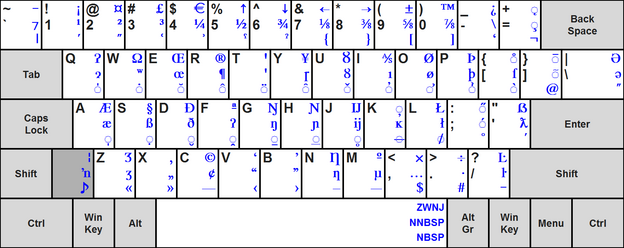ISO / IEC 9995
ISO / IEC 9995 Information technology - Keyboard layouts for text and office systems is a series of international standards on which national standards such as the DIN standard DIN 2137 keyboards for data and text input are based .
The series of standards has existed since 1994 and has been updated numerous times since then.
Components of the standard series
The series of standards currently (March 2017) consists of the following individual international standards:
- ISO / IEC 9995-1: 2009 General principles governing keyboard layouts
- ISO / IEC 9995-2: 2009 Alphanumeric section with Amendment 1 (2012) Numeric keypad emulation
- ISO / IEC 9995-3: 2010 Complementary layouts of the alphanumeric zone of the alphanumeric section
- ISO / IEC 9995-4: 2009 Numeric section
- ISO / IEC 9995-5: 2009 Editing and function section
- ISO / IEC 9995-7: 2009 Symbols used to represent functions with amendment 1 (2012)
- ISO / IEC 9995-8: 2009 Allocation of letters to the keys of a numeric keypad
- ISO / IEC 9995-9: 2016 Multilingual usage, multiscript keyboard group layouts
- ISO / IEC 9995-10: 2013 Conventional symbols and methods to represent graphic characters not uniquely recognizable by their glyph on keyboards and in documentation
- ISO / IEC 9995-11: 2015 Functionality of dead keys and repertoires of characters entered by dead keys
ISO 9995-6: 2006 Function section was withdrawn on October 8, 2009, as it was incorporated into ISO / IEC 9995-5: 2009 Editing and function section (previously ISO / IEC 9995-5: 2006 Editing section ) was integrated.
ISO / IEC 9995-3
ISO / IEC 9995-3: 2010 defines a secondary group of characters ( "common secondary group" ) for alphanumeric keyboards. The characters of this group are shown on the right half of the key area; the standard defines their positions independently of the characters present in the primary layout. For example, the yen symbol "¥" is always displayed in the upper case position of the 6th letter key in the second row from the top, i.e. on QWERTZ keyboards like the German assignment on the "Z" key, on QWERTY keyboards like the US assignment, however, on the "Y" key.
ISO / IEC 9995-3: 2010 applied to the US keyboard layout
ISO / IEC 9995-3: 2010 used in the extended German assignment T3 according to DIN 2137 : 2012-06
In addition, the standard defines an “ outdated common secondary group” exclusively for compatibility purposes. This corresponds to the “common secondary group” defined in the earlier standard version ISO / IEC 9995-3: 2002.
The diacritical marks in the "common secondary group" are dead keys , ie they are entered before the basic letter. This also applies to sequences of multiple diacritical marks, such as B. are required to enter Vietnamese texts.
Furthermore, ISO / IEC 9995-3: 2010 defines a list of “special characters that can be entered as a combination with diacritical marks” ( “Peculiar Characters which can be entered as combinations using diacritical marks” ). This list contains combinations of one diacritical and one additional character. For example, the inequality sign “≠” ( Unicode U + 2160) can be entered in this way. Specifically, letters with a horizontal slash (such as Serbo-Croatian đ / m or Maltese Ħ / werden) are entered using the “ cross accent ” placed on the “K” key.
swell
- ↑ ISO catalog - ISO / IEC 9995-1: 2009
- ↑ ISO catalog - ISO / IEC 9995-2: 2009
- ↑ ISO catalog - ISO / IEC 9995-2: 2009 / Amd 1: 2012
- ↑ ISO catalog - ISO / IEC 9995-3: 2010
- ↑ ISO catalog - ISO / IEC 9995-4: 2009
- ↑ ISO catalog - ISO / IEC 9995-5: 2009
- ↑ ISO catalog - ISO / IEC 9995-7: 2009
- ↑ ISO catalog - ISO / IEC 9995-7: 2009 / Amd 1: 2012
- ↑ ISO catalog - ISO / IEC 9995-8: 2009
- ↑ ISO catalog - ISO / IEC 9995-9: 2016
- ↑ ISO catalog - ISO / IEC 9995-10: 2013
- ↑ ISO catalog - ISO / IEC 9995-11: 2015
- ↑ ISO catalog - ISO / IEC 9995-5: 2006
- ↑ ISO catalog - ISO / IEC 9995-6: 2006
- ^ Karl Pentzlin: Information about the Revision of ISO / IEC 9995-3 (PDF; 504 kB), October 23, 2010 (accessed September 18, 2011)
- ^ Karl Pentzlin: German PC keyboard extended for international correspondence . In: DIN-Mitteilungen 2/2011, p. 31 ff.


